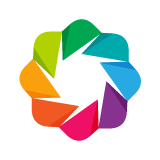#!/usr/bin/env python
# coding: utf-8
#
#
#
#
#  #
#
#
# |
#
# Bokeh 教程
# |
#
#
#
# 04. 数据源和数据转换
# In[1]:
from bokeh.io import output_notebook, show
from bokeh.plotting import figure
# In[2]:
output_notebook()
# # 概要
#
# 我们已经看到Bokeh怎么能够很好地与Python列表、NumPy数组、Pandas序列一起工作。在底层,这些输入数据被转换为Bokeh的`ColumnDataSource`类型。这个数据类型是Bokeh使用的核心数据源对象。虽然Bokeh经常通过透明的方式创建该类型对象,但有些时候也需要通过显式的方式创建。
#
# 下一节,我们会看到hover tooltips,computed transforms 和 CustomJS interactions 等使用`ColumnDataSource`的功能,所以,现在我们快速的瞄一眼。
# ## 通过 Python Dicts 创建
#
# 从 `bokeh.models` 导入 `ColumnDataSource`:
# In[3]:
from bokeh.models import ColumnDataSource
# `ColumnDataSource`是从列名(字符串)到值序列的映射。下面是一个简单的例子。映射是通过传入Python `dict`建立的,其字符串键作为列名,对应的Python list作为值序列。该值序列也可以是NumPy数组,或Pandas序列。
#
# ***注意:`ColumnDataSource` 中所有的列必须等长。***
#
# In[4]:
source = ColumnDataSource(data={
'x' : [1, 2, 3, 4, 5],
'y' : [3, 7, 8, 5, 1],
})
# 到目前,我们已经通过直接传入文本列表或数组数据的方式调用函数,如`p.circle`。当我们这样做时,Bokeh会自动帮我们创建一个 `ColumnDataSource`。但我们也可以显式地把 `ColumnDataSource` 作为 `source` 参数传入glyph函数。当我们这样做时,如果我们想要给一个属性(如`"x"` 或 `"y"` 或 `"fill_color"`)指定一个值序列,我们传入对应的***列名***:
# In[5]:
p = figure(plot_width=400, plot_height=400)
p.circle('x', 'y', size=20, source=source)
show(p)
# In[6]:
# Exercise: create a column data source with NumPy arrays as column values and plot it
# ## 通过 Pandas DataFrames 创建
#
# 通过Pandas Dataframe创建 `ColumnDataSource` 对象也很容易。只需要在创建 `ColumnDataSource` 的时候把Dataframe传入就行:
# In[7]:
from bokeh.sampledata.iris import flowers as df
source = ColumnDataSource(df)
# 现在我们就可以使用这个对象绘制上例中的图了,把对应的列名传入glyph函数:
# In[8]:
p = figure(plot_width=400, plot_height=400)
p.circle('petal_length', 'petal_width', source=source)
show(p)
# In[9]:
# Exercise: create a column data source with the autompg sample data frame and plot it
from bokeh.sampledata.autompg import autompg_clean as df
 #
#
#
#  #
#
#
#